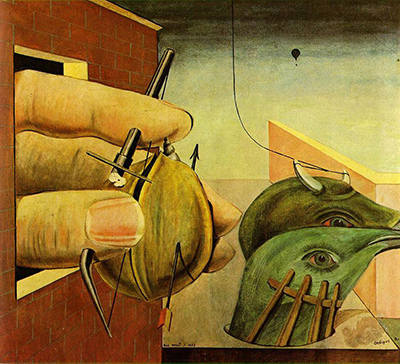Oedipus Rex is an oil on canvas symbolic painting executed in 1922 by Max Ernst. The painting is one of his most famous works.
On the left side of this painting, fingers are emerging from a brick wall. They are holding a walnut that's pierced by a bow-like device. On the right side of the painting, there are two birds: One with horns upon which a string is attached and the other bird is positioned against a wooden fence. The birds are inside a box that can only allow them to show their heads. There is also a hot balloon in the background.
The painting looks motionless with still subjects. Although this work is quite asymmetrical (with some scattered elements), there is a certain harmony due to the elements counterbalancing each other. Additionally, the colours in the painting are realistic. The dark colours in the creases of some elements of Oedipus Rex such as the tow birds, walnut and fingers create depth while emphasising their forms. There are some invisible lines guiding the eye of the viewer through the piece such as the edges of the walls. The tridimensional aspect and the presence of background and foreground give this work a lot of depth.
The painting is typically Freudian in content and name. The Oedipus complex is among the most well-known components of Freud's theories. It's seen in this painting names after it in several ways. For instance, the use of a joke. This can be seen in how the artist has treated various objects in this work. These include the juxtaposition and contrast of the wall, the balloon in the near the painted collage, upside-down eyes seen on the birds and the over-sized fingers.
The work has strong, intense sexual undercurrents. The crack symbolises the vulva and the walnut represents a female. The cracking of the walnut by the male hands is a metaphor for sex and gender roles in patriarchal cultures. It's also theorised that the squeezing of the walnut has indications of sadomasochistic roles. As the walnut is being crushed and dominated, the spike is also punishing the hand. Once forced open, the walnut can shut quickly and injure the index finger. This signifies neurotic sexual attachment.
In the picture, the head of the bird is tethered by a rope. This symbolises societal restrictions on aberrant sexuality and the reaction to the taboo linked to incest. The arrow - as it's piercing the shell of the walnut - can also be a phallic signifier or a symbol for the concept of love, then the denial that love exists within the constraints of sexuality and sexual desire. The imagery in this painting intensely involves the psychological aspects of sexual impulse.




